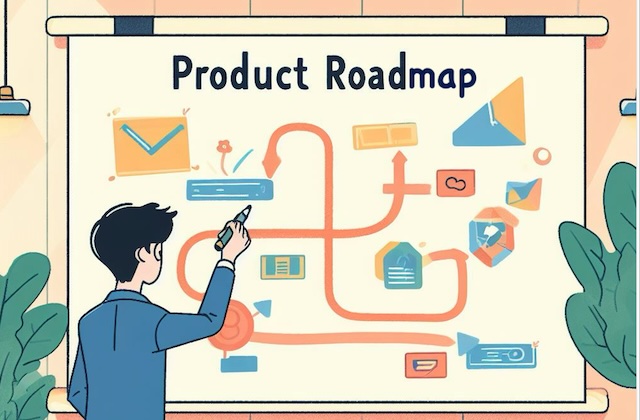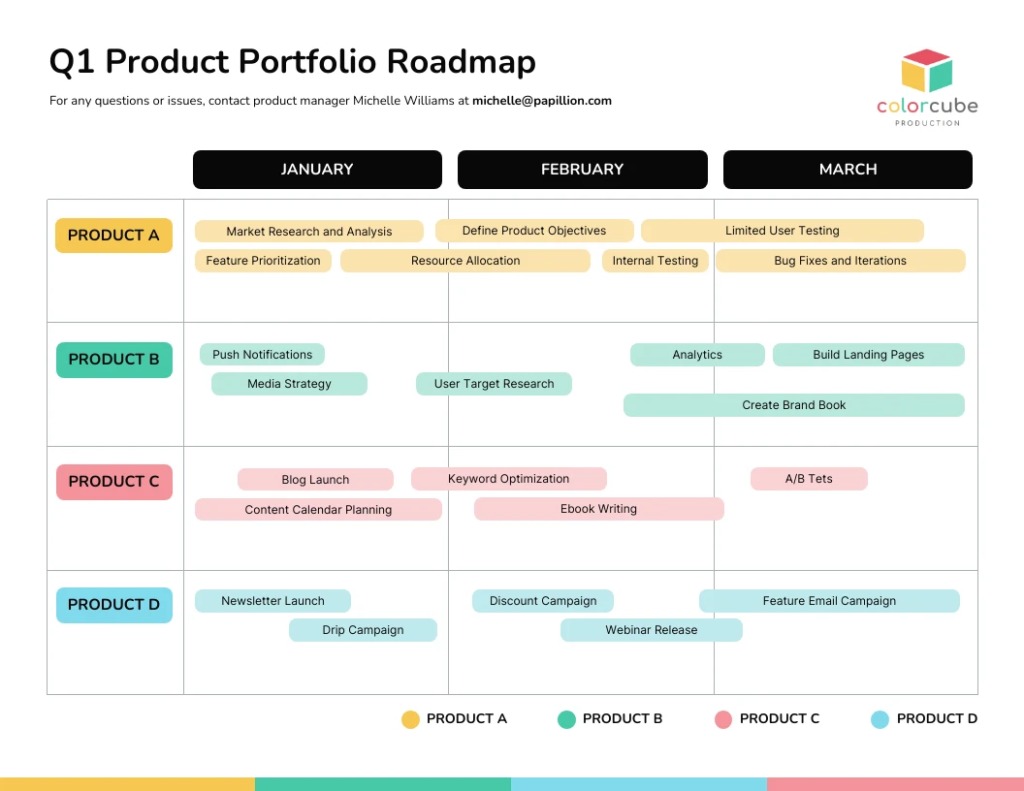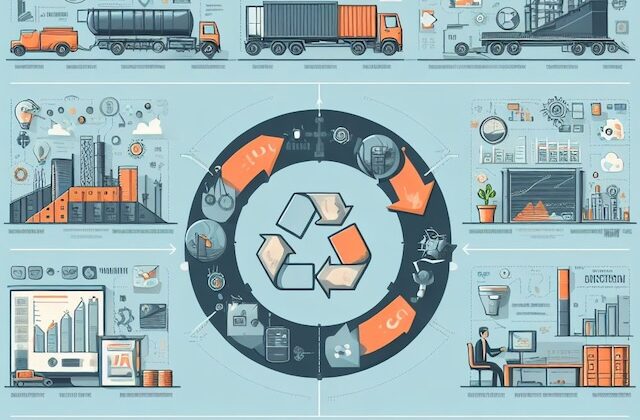
Product Roadmap
“Product managers should be the most curious people in the room, always asking ‘why’ and ‘what if’.”
– Marty Cagan
Welcome to Day 20 of the PM series – Product Management in 30 Days!
In the fast-paced world of product management, a well-crafted product roadmap is your guiding star. It serves as a strategic plan, aligning your team’s efforts with your product’s overall vision and goals.
This extensive post will delve deep into product roadmapping, exploring its essence, best practices, advanced strategies, and a real-world example to illuminate the path toward successful product development.
Learning Objectives
- Understanding Product Roadmap Essentials: Define a product roadmap as more than a feature timeline. Recognize it as a visual representation of product strategy.
- Grasping the Essence of Product Roadmap: Identify the key components of a product roadmap, including direction, priorities, and major milestones. Understand how a well-constructed roadmap aligns teams and facilitates communication.
- Creating an Effective Product Roadmap: Outline the four key steps involved in creating an effective product roadmap. Understand the importance of defining product vision, setting objectives, prioritizing features, and creating a visual roadmap.
- Communicating and Sharing the Roadmap: Differentiate between internal and external communication of the roadmap. Recognize the significance of effective communication with cross-functional teams, stakeholders, customers, and partners.
- Goal-Based Product Roadmap: Define a goal-based product roadmap as a strategic planning tool aligning development with business objectives. Identify the five essential elements of a goal-based product roadmap, including timeframe, version, goal, feature, and metric.
Introduction
A product roadmap is more than just a timeline of features; it’s a visual representation of your product strategy. It helps stakeholders understand the direction of your product, the key milestones along the way, and how specific features contribute to achieving overarching goals. Let’s embark on this journey to master the art of product roadmapping.

🛣️ The Essence of Product Roadmap
A product roadmap is a high-level visual representation of your product’s strategic vision. It outlines the direction, priorities, and major milestones your product will achieve over a specific period. A well-constructed product roadmap:
- Aligns Teams: It aligns cross-functional teams by providing a shared vision and clear priorities.
- Facilitates Communication: It facilitates communication with stakeholders, ensuring everyone understands the product’s direction.
- Allows Flexibility: Roadmaps can adapt to changes in market dynamics, technology, and user feedback.
#️⃣ Creating an Effective Product Roadmap
Creating an effective product roadmap involves four key steps:
- Defining Product Vision – Begin by clearly defining the product’s vision and long-term goals. What problem is the product solving, and what value does it bring to users?
- Setting Objectives and Key Results (OKRs) – Align the roadmap with specific objectives and key results. This ensures that each feature or release contributes to overarching goals.
- Prioritizing Features – Prioritize features based on factors such as user impact, business value, and technical feasibility. Various frameworks, such as the MoSCoW method or the RICE scoring model, can help with prioritization.
- Creating a Visual Roadmap – Choose a visual format for your roadmap, such as a timeline, Gantt chart, or Kanban board. Ensure it’s easy to understand and share with stakeholders.
#️⃣ Communicating and Sharing the Roadmap
Effective communication and sharing of the roadmap are crucial:
🔹 Internal Communication: Share the roadmap with cross-functional teams, including engineering, design, marketing, and sales. Ensure everyone understands the product’s direction and their roles in achieving it.
🔹 External Communication: Externally communicate the roadmap to key stakeholders, customers, and partners. Manage expectations and build trust by providing transparency.
🎲 Goal Based Product Roadmap
A goal-based product roadmap is a strategic planning tool that aligns a product’s development with specific business objectives. Instead of focusing solely on features or releases, this roadmap prioritizes goals and key metrics, allowing product teams to measure success in terms of achieving those objectives. The goal-based approach ensures that product development efforts are directly tied to broader business goals, fostering alignment and strategic impact.
Five Elements of a Goal-Based Product Roadmap:
- Timeframe: Defines the duration or timeline for achieving the outlined goals. It helps set expectations for when specific objectives should be realized.
- Version: Specifies the product version or iteration associated with each set of goals. Versions may represent major releases, updates, or milestones in the product’s evolution.
- Goal: Clearly articulates the overarching business objective or outcome that the product team aims to achieve within a specified timeframe. Goals are typically measurable and tied to the organization’s strategic priorities.
- Feature: Identifies the key features or functionalities that will be developed to support the attainment of the defined goals. Features are the building blocks that contribute to goal achievement.
- Metric:Establishes measurable metrics or key performance indicators (KPIs) that will be used to assess the success of each goal. Metrics provide a quantifiable way to evaluate progress and impact.
In its simplest form, the product roadmap for a App will look like this:
| Timeframe | Q1-Q2 2023 | Q3-Q4 2023 | Q1-Q2 2024 | Q3-Q4 2024 |
| Version | v2.0 | v2.1 | v3.0 | v3.1 |
| Goal | Increase User Engagement | Enhance User Retention | Expand Market Reach | Improve User Satisfaction |
| Feature | Implement Gamification Features, Introduce Social Sharing | Introduce Personalized User Recommendations, Implement In-App Messaging | Launch Multi-language Support, Enhance Accessibility Features | Revamp User Interface, Implement Advanced Search Functionality |
| Metric | Daily Active Users (DAU), Social Shares | Monthly Churn Rate, In-App Message Engagement | New User Acquisition, User Engagement in Multiple Languages | Net Promoter Score (NPS), User Satisfaction Surveys |
💁♀️ Real-World Example: Building a TV App Roadmap for Live Sports Streaming
Imagine you’re a product manager for a TV app software company.
*️⃣ Vision: To become the go-to platform for live sports streaming, offering sports enthusiasts a seamless, interactive experience.
*️⃣ Key Goals:
- Achieve 2 million monthly active users within the first year.
- Offer live streaming of key sports events, including NFL, NBA, and Premier League matches.
- Implement interactive features like live polls, in-game statistics, and social sharing during live broadcasts.
*️⃣ Prioritization:
- Personalization features that recommend sports events based on user preferences.
- Cross-device compatibility to ensure viewers can switch between their TV, smartphone, and tablet.
- Integration with popular streaming platforms and devices.
- Developing partnerships with major sports leagues for exclusive content.
*️⃣ Product Roadmap Implementation:
Q1: Launch TV app on major platforms (Roku, Apple TV, Amazon Fire Stick).
Q2: Release personalization features and cross-device syncing.
Q3: Secure partnerships with NFL and NBA for live streaming rights.
Q4: Implement interactive features and launch marketing campaigns.
*️⃣ Results:
Within the first year, your TV app attracted 2.5 million monthly active users, surpassing the initial goal. Live sports streaming becomes a significant draw, increasing user engagement and advertising revenue. The app gained recognition for its interactive features, setting a new standard in the live sports streaming industry.
Are Product Roadmaps and Portfolio Roadmaps the same?
A portfolio roadmap is a strategic planning tool used by organizations to visualize and communicate the overarching direction and priorities of multiple projects or products within a portfolio. It provides a high-level overview of how individual projects contribute to the organization’s overall goals and objectives. The portfolio roadmap helps stakeholders understand the sequencing, dependencies, and resource allocation across various initiatives.
Here is an example for Product Portfolio roadmap

Credit : Von Venngage Inc.
Comparison of Portfolio Roadmap and Product Roadmap:
| Aspect | Portfolio Roadmap | Product Roadmap |
| Scope | Encompasses multiple projects or products within an organization’s portfolio. | Focuses on a specific product or a set of related features. |
| Level of Detail | Provides a high-level overview of projects and their alignment with strategic goals. | Offers a detailed plan for the development and enhancement of a specific product. |
| Audience | Targets executives, stakeholders, and teams involved in managing a portfolio of projects. | Primarily addresses product managers, development teams, and stakeholders of a specific product. |
| Timeline | Typically covers a longer timeframe, often spanning several years. | Generally focuses on shorter-term timelines, such as quarterly or bi-annual plans. |
| Resource Allocation | Illustrates how resources are allocated across various projects within the portfolio. | Details resource allocation for specific features or releases of a single product. |
| Dependencies | Emphasizes inter-project dependencies to show the sequencing of initiatives. | Focuses on dependencies related to the development and release of specific product features. |
| Strategic Alignment | Ensures that all projects within the portfolio align with the organization’s overall strategy. | Aligns the product’s development plan with the broader business and market strategy. |
| Flexibility and Adaptability | Requires adaptability to changes in the overall organizational strategy. | Requires flexibility to respond to changing market conditions, user feedback, and technological advancements. |
Best Practices and Pitfalls 😱
➡️ Best Practices
- Regular Updates: Keep the roadmap up-to-date to reflect changing priorities and progress.
- Transparency: Share the roadmap with all stakeholders to ensure alignment and foster trust.
- Communication: Use the roadmap as a communication tool to explain the why, when, and what of your TV app’s journey.
➡️ Pitfalls to Avoid
- Overcommitting: Avoid overloading your roadmap with features, leading to missed deadlines and disappointed stakeholders.
- Lack of Flexibility: Failing to adapt to changing circumstances can render your roadmap obsolete.
🔔 Conclusion
A well-constructed Product Roadmap serves as the bridge between the grand vision and the detailed execution. It keeps product teams aligned, customers satisfied, and companies competitive. By understanding its connection to vision and strategy and learning from real-world examples like TV Software company, product managers can confidently navigate the complex journey of product development.
Quiz Time
Question 1: What is a product roadmap primarily used for?
A) Defining product features
B) Visualizing product strategy
C) Managing project timelines
D) Conducting market research
Question 2: What is one key benefit of an effective product roadmap?
A) Decreasing team collaboration
B) Hiding product direction from stakeholders
C) Aligning cross-functional teams
D) Keeping information exclusive to product managers
Question 3: What are the four key steps in creating an effective product roadmap?
A) Feature selection, budget allocation, team collaboration, market analysis
B) Defining product vision, setting objectives, prioritizing features, creating a visual roadmap
C) Conducting user interviews, writing code, testing, launching
D) Quarterly planning, monthly sprints, weekly stand-ups, daily scrums
Question 4: What is a goal-based product roadmap designed to prioritize?
A) Random feature additions
B) Short-term bug fixes
C) Business objectives and key results (OKRs)
D) Daily task management
Question 5: Name one element that is part of a goal-based product roadmap.
A) Stakeholder communication
B) Budget allocation
C) Feature prioritization
D) Metric
✍️ Write your answers in the comment section. e.g 1-a, 2-b, 3-c etc.
If you want to learn more about product management, you can also find other posts. The Full series is available here
One of the recommended books to learn about product management is Product Roadmaps Relaunched by C. Todd and Bruce
💌 Do drop me a comment below if you found the content useful and/or want me to write on a specific topic. This will make my day! 🙂
Also, share the post if you think this might help someone. The sharing link is at the top of the page.
Join FreeMentor as a student if you are a newbie in product management and want to have one Free 1:1 mentorship session.
Disclaimer:
Please note that I don’t make any guarantees about the information supplied in this post. I share educational and informational resources that are intended to help you succeed in understanding product management. You nevertheless need to know that your ultimate success or failure will be the result of your own efforts, your particular situation, and innumerable other circumstances beyond my knowledge and control.
#ProductManagement #ProductRoadmap #Vision #Strategy #RealWorldExample #ProductDevelopment #Agile #CustomerFeedback

